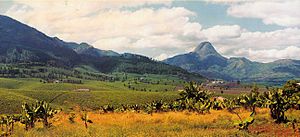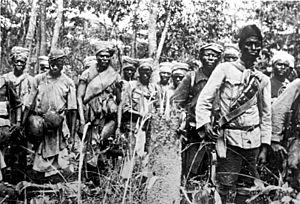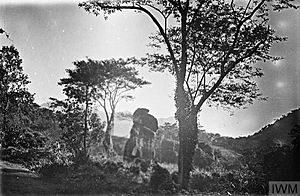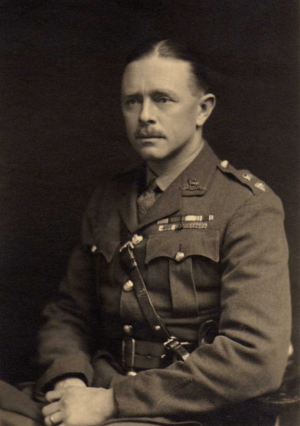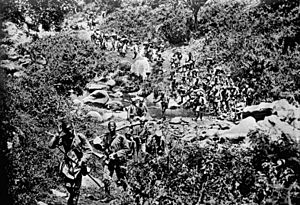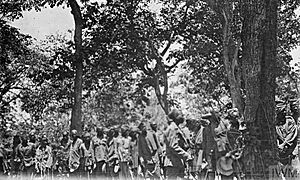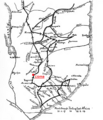Battle of Lioma facts for kids
Quick facts for kids Battle of Lioma |
|||||||
|---|---|---|---|---|---|---|---|
| Part of East African Campaign of World War I | |||||||
 Lioma during the Mozambique Campaign. |
|||||||
|
|||||||
| Belligerents | |||||||
|
|||||||
| Commanders and leaders | |||||||
| Units involved | |||||||
|
|
|
||||||
| Strength | |||||||
| 1,600+ | c. 3,000 | ||||||
| Casualties and losses | |||||||
| 29 killed, 27 wounded, 34 missing, 5 captured (German claim) 222 killed, missing or captured (British claim) |
32 killed, 59 wounded, 15 missing among 1/1st KAR; casualties of other British battalions unreported | ||||||
The Battle of Lioma happened on August 30–31, 1918, during World War I. It was fought in Portuguese East Africa (now Mozambique). This battle was part of the East African Campaign.
The battle was between the German Schutztruppe (colonial protection force) and the British King's African Rifles. The German forces, led by Paul von Lettow-Vorbeck, had been avoiding the Allies since late 1917. They were fighting a guerrilla war (small, surprise attacks) in Portuguese East Africa. Their goal was to find supplies and damage the Allied forces.
The British King's African Rifles chased the Germans. They finally trapped them near the village of Lioma. British forces, led by George Giffard, almost surrounded and destroyed the Schutztruppe. However, the Germans managed to break out and escape. Even though the Germans were much weaker after Lioma, they kept fighting until the end of the war.
Contents
Why the Battle Happened
By 1917, the German forces in German East Africa had suffered many losses. Their leader, Lettow-Vorbeck, decided to move into Portuguese East Africa. He hoped to find enough supplies there to keep fighting.
The Germans were successful in getting supplies. They took food from the countryside. They also defeated Portuguese forces several times, like at the Battle of Ngomano. This allowed them to capture many weapons, ammunition, and medical supplies. Some historians even said the Portuguese became "unwilling quartermasters" for the Schutztruppe. Since the Portuguese couldn't stop the Germans, the British had to take over the main fighting in Mozambique. They started to aggressively chase Lettow-Vorbeck's small army.
By August 1918, the Schutztruppe was heading north, trying to return to German East Africa. The British, under Jacob van Deventer, planned to trap them. They gathered their forces near Regone and Lioma. Lettow-Vorbeck knew about the British plans. However, his troops desperately needed supplies. Regone had a large supply depot.
Lettow-Vorbeck planned a quick attack on Regone to get supplies. Speed was very important to avoid the British. But rough terrain, rain, and fog slowed the Germans down. When they reached Regone on August 26, the British had already made it stronger. The Germans couldn't take Regone without a long fight, which they didn't have time for. So, Lettow-Vorbeck decided to skip Regone. Instead, he marched his forces towards Lioma, another supply depot.
What the Germans didn't know was that a British battalion (1/1st KAR) had already reached Lioma on August 28. Two other British battalions were also marching quickly towards Lioma. The British plan was to trap the Schutztruppe between their forces at Regone and Lioma. If the plan worked, the German army would be destroyed.
British scouts bothered the approaching German forces. Meanwhile, the 1/1st KAR, led by Major Alexander Charles Masters, dug in at Lioma. They set up a square defense south of the village. They also placed three small outposts to the west, east, and south. The Lioma defenders waited for the Schutztruppe, who arrived on August 30.
Who Was Fighting
German Forces
By 1918, the Schutztruppe was much smaller and very tired. It had once been strong and fought the Allies for four years. But from about 15,000 soldiers in 1916, only about 1,600 were left. Many African and European soldiers had left or given up. This happened as the Allies took over their home areas. Also, soldiers were no longer paid, and army life became very hard. Many soldiers were too sick or hungry to fight.
The Schutztruppe had lost its territory and couldn't easily get new soldiers. This meant they had very few common soldiers. But their officers and non-commissioned officers (NCOs) were very important and hard to replace. The Schutztruppe could only keep fighting because of its experienced leaders.
Even with all these problems, most of the black soldiers who had served since before the war were still loyal to Lettow-Vorbeck. Their fighting spirit remained strong. They were tired, had little food, and faced a tough enemy in the King's African Rifles. But these core soldiers refused to give up. They were tough fighters, skilled in bush-warfare, and had a strong team spirit. Lettow-Vorbeck himself said his men fought "brilliantly" at Lioma. However, courage alone couldn't make up for a lack of supplies and new soldiers. By 1918, the Schutztruppe couldn't face strong enemy groups head-on without risking being destroyed.
British Forces

The British soldiers at Lioma were part of the King's African Rifles (KAR). This part of the British colonial army had been ignored for a long time. But after 1915, the KAR proved to be very effective against the Schutztruppe. So, they were greatly expanded and improved. Their fighting methods were changed to match the German bush warfare. They also received better equipment and weapons.
Unlike the Germans, the KAR could get new soldiers and supplies. However, because the KAR grew so much, most of its troops were new recruits. They didn't have as much experience as the tough Schutztruppe. For example, at Lioma, the 1/1st KAR was mostly new recruits from Nyasaland (now Malawi). They had only a few experienced soldiers.
Also, the very bad or non-existent roads in Mozambique made it hard to supply the large numbers of KAR soldiers. These soldiers were chasing the small Schutztruppe. So, both British white officers and African soldiers often had to live off the land. They were often close to starvation, just like the Germans. One report said that officers and men of one unit looked like "victims of famine" after their time in the field. This shows how hard conditions were for everyone.
"Colonel Gifford [sic.] himself, an efficient and tireless soldier, expected his officers and men to be the same. Cool and collected in any engagement, he was, as I have said, with his column, our one redeeming feature in this 1918 campaign in P.E.A. (...) without Colonel Gifford [sic.] and the K.A.R. 2nd Col. it might easily have been almost disastrous."
Despite these tough conditions, the British African soldiers were generally very strong and skilled fighters. They were motivated by loyalty and their relatively good pay. The white and black officers and NCOs of the King's African Rifles also led by example. They suffered many losses, but unlike the Germans, the British could replace them fairly quickly. However, new British white officers often couldn't speak Swahili (the common language in the region). This made it hard to talk with their men.
One of the most important British commanders in Mozambique was Lt-Col George Giffard. He led a special group (K.A.R. 2nd Col. or "KARTUCOL") to find and destroy Lettow-Vorbeck's remaining troops. Both his own forces and the Germans respected him highly. His troops would help the Lioma defenders on the second day of the battle.
The Battle of Lioma
First Day: German Attack (August 30)
The Schutztruppe arrived near Lioma on August 30. The British forces at Lioma had seen the Germans coming hours before. This allowed them to make their defenses stronger. In fact, as the German groups (called Abteilungen or Abt) moved towards the village, one of the British relief units, 3/2nd KAR, arrived around noon. They took up positions northeast of the 1/1st KAR's main defense.
While the new battalion was getting ready, the German lead group, Abt Müller, met a small British platoon (part of 1/1 KAR) east of Lioma. This led to a first skirmish. The German soldiers then pulled back south. When Lettow-Vorbeck heard about this fight, he thought the British hadn't made their positions strong yet. He believed the enemy was still weak. So, he ordered Abt Göring and Abt Müller to attack the sides of the 1/1st KAR's main position. Abt Poppe was sent to attack and take over the British outpost around 2:30 PM. The British tried to help their isolated platoon but failed. Captain Poppe was seriously wounded during the British counter-attack. Because the Germans were trying to surround them, communication between 1/1st and 3/2nd KAR was cut off.
Around 4:30 PM, the Germans launched a strong attack on the 1/1st KAR's main position. About 1,000 men and 30 machine guns were involved. Abt Müller attacked from the east and north first, followed by Abt Poppe from the south. At the same time, 3/2nd KAR launched several counter-attacks against the Germans. They captured Abt Müller's supplies and extra ammunition. They also stopped Abt Göring from trying to flank 1/1st KAR. Since he couldn't advance further, Captain Karl Göring ordered part of his force to fight 3/2nd KAR. The rest attacked the western side of 1/1 KAR's defense.
The strong German attacks caused many problems for the British. Many carriers (people who carry supplies) ran away, and many soldiers were hurt or killed. Several senior officers of the battalion were killed or wounded, including Major Masters. Captain Stanley Conway John took command of 1/1 KAR. Despite this, the 1/1st KAR's African soldiers held their ground. They were reported to have "excellent" shooting skills. One small German group did break into the northwest corner of the British defense, but they were quickly killed. The Schutztruppe continued its attacks until 10:30 PM. By then, Göring saw that his troops were losing too many men. He decided to pull back. The German units then retreated south to rejoin the rest of their forces.
Second Day: German Escape (August 31)
During the night, Lettow-Vorbeck decided his forces had to escape Lioma by moving east. He knew the Schutztruppe needed a break, and more enemy units were coming. On the other side, 2/2nd KAR had reached Lioma. Also, 1/2nd KAR was getting close to the Nalume River crossing, east of the village. So, by early August 31, three British battalions were near Lioma. A fourth was marching to block the most important escape route to the east. Lt-Col Giffard, who had arrived with 2/2nd KAR and now commanded all British forces, saw a good chance to finally trap and defeat the Schutztruppe.
The German forces started moving northeast towards the Lioma-Muanhupa road at 9:00 AM on August 31. They had regrouped during the night. To move faster, they left behind seriously wounded and sick soldiers, as well as prisoners. These were later captured by the British. The German lead groups were again Müller and Göring. General Major Kurt Wahle led the main group. Captain Stemmermann was in charge of the rearguard (the group protecting the back). Lettow-Vorbeck moved freely among his forces to oversee their movement and help where needed.
Even though the British sent out patrols all night to find the Schutztruppe, they only learned about Lettow-Vorbeck's movement at 10:00 AM. Giffard then ordered 2/2nd KAR and half of 3/2nd KAR to move east. He ordered 1/2nd KAR to march west. The goal was to trap the German forces between them. The 1/1st KAR, which was badly shaken from the previous day's fighting, stayed at Lioma to guard British supplies. The other half of 3/2nd KAR was kept as a mobile reserve.
Two companies (groups of soldiers) from 2/2nd KAR met the side of the German lead group on the Lioma-Muanhupa road around noon. A tough but slow fight started with Abt Müller and Abt Göring. Other parts of 2/2nd and 3/2nd KAR tried to go around this lead group. They wanted to attack the main German force to scatter their carriers and capture supplies. This would have been a huge blow to the Schutztruppe's ability to get supplies.
However, the German main force was well hidden by the bush and rough hills. They avoided the British to the west and managed to move east along the road. Then they took a trail into the northern hills. After meeting 2/2nd and 3/2nd KAR, Lettow-Vorbeck first thought he could destroy them with a strong counter-attack using all his forces. But he dropped this plan when it became clear that the German main force had already moved too far north to be called back.
Meanwhile, without the Germans knowing, 1/2nd KAR marched southwest along the Lioma-Muanhupa road. They met parts of the Schutztruppe's rearguard by 2:30 PM. The 1/2nd KAR completely surprised the defenders. They managed to take over a whole enemy field hospital with almost no resistance. Only a few snipers slowed their advance. Then, 1/2nd KAR moved into the northern hills where the German main force and the rest of the rearguard were. They quickly came under machine gun fire. This only stopped the King's African Rifles soldiers briefly. Overall, the German rearguard offered little resistance to 1/2nd KAR. They were forced to retreat north in a disorganized way around 3:00 PM.
While this was happening, Lettow-Vorbeck had already ordered his western units to retreat after Captain Göring was wounded. He had lost several officers and NCOs on the first day of the battle. He simply couldn't risk any more losses among them. Because the difficult land made communication almost impossible between the different groups, Lettow-Vorbeck only noticed the attack on his rearguard units when he had started climbing the northern hills with the retreating Abt Göring and Abt Müller. By then, it was too late for the German commander to contact or help the now struggling forces of Stemmermann and Wahle.
The Germans didn't suffer more losses in their rearguard thanks to false reports from captured German African soldiers. When questioned by 1/2nd KAR, they greatly exaggerated how strong the Schutztruppe still was. This discouraged the 1/2nd KAR, who stopped chasing the Germans. They regrouped and only cautiously started moving forward again at 4:00 PM. The British forces coming from the east and west finally met around 5:00 PM. By this time, all German units had managed to escape north.
However, because of the difficult land, communication between the retreating Schutztruppe forces had become "hopelessly muddled." Order had largely broken down. The western lead units, trying to climb the steep northern granite hills, got lost. The situation among the main group was also chaotic. Only late into the night was Lettow-Vorbeck, who was still with Abt Müller and Abt Göring, able to get back in touch and eventually reunite with the main group under Wahle. One German group under Captain Köhl even got so completely lost that it took several days to reunite with the rest of the Schutztruppe.
What Happened Next
The British had failed to finally destroy the Schutztruppe. However, they had caused many losses for the Germans. The exact number of losses is debated. Lettow-Vorbeck claimed he lost 29 killed, 27 wounded, 34 missing, and 5 captured. British claims are around 222 killed, missing, or captured, with 22–26 of them being White soldiers. These differences might be because the Germans didn't count non-fighters like medical staff as casualties. No matter the exact numbers, several important German officers and NCOs were killed, captured, or wounded. This was a big blow to the Schutztruppe.
The Germans also failed to take Lioma, so they couldn't get new supplies. Instead, they lost 50,000 rounds of ammunition, important medical supplies, and about 200 carriers. These carriers had scattered during the battle. One historian, Miller, said that "the Germans had been more than bruised at Lioma; but for the almost total disorder and confusion [on both sides] that marked the two-day action, they would have been wiped out." Edward Paice called the Battle of Lioma a "narrow escape" for the Germans. When combined with their losses during the Battle of Pere Hills (another close call soon after Lioma), Lettow-Vorbeck's forces lost 15% of their fighting strength. Many of those wounded at Lioma didn't recover enough to fight again, including Göring.
In September 1918, a lung sickness spread among the Schutztruppe. This further reduced the number of German soldiers and lowered their spirits. Many of the surviving White Germans started to question Lettow-Vorbeck's plan to keep fighting for what they saw as a lost cause. Still, the Schutztruppe did not surrender. They continued their march north. After Pere Hills, they traveled the rest of the way to German East Africa mostly without being stopped. Although much smaller and weaker, they continued to fight until the end of the war.
For the British, Lioma had been "the best chance [...] to inflict a decisive defeat upon the Schutztruppe." Lt-Col Giffard later said that the British failed to surround the Germans because of difficult communication between British units. Also, they didn't have enough information about enemy movements. He called this "the difficulty which is always the same in the Bush of getting information accurately and quickly."
The British casualties at Lioma were mostly not reported. We only know that 1/1st KAR had 32 killed, 59 wounded, and 15 missing. After the battle, four Distinguished Conduct Medals were given to European soldiers. Seven African Distinguished Conduct Medals were given to African soldiers of the 1/1st and 1/2nd KAR for their bravery. The Distinguished Service Order was given to the commanders of 1/1st KAR (Alexander Charles Masters), 1/2 KAR (Edward Beckford Bevan), and 3/2 KAR (Charles George Phillips).
Images for kids


